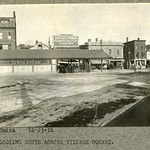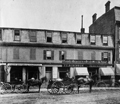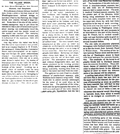|
The Society
Historical Information
Photo & Map Collections
Exploring Brookline
Links
Program Archives
|
Brookline Village
 |
Lower Washington St. At Entrance to Walnut St.
Brookline House, 108 Washington St., an eating establishment and boarding house started by Aaron Whitney circa 1865 and closed circa 1874. Comstock, Gove & Co. is making a delivery. A Boston firm, they bottled soda water and eventually expanded to making liquor.
|
 |
Brookline Village, circa 1899
Looking West on Washington St. toward the link with Boylston St. Walnut St. is off photo left foreground. This is one of two photos taken from slightly different positions. From left to right:
- The left side of the apartment building at the entrance to Walnut St. is a rooming house.
- The right side of the apartment building will be converted in early 1900 to a store front.
- #164 Washington St., corner of the Guild Building: Thomas H. McMahon, Grocer
- Washington St. curving north
- #129 Washington St., the four-story brick building: Jacob Morlock, Bakery/Restaurant
- #121 Washington St.: William F. Young, Grocer. Note the cat out front by the curb.
- #115/117 Washington St.: M. Cavicchi, Fruits, Nuts, Figs. Note what appear to be small Christmas trees stacked outside.
[Source: Brookline Preservation Department]
|
 |
Brookline Riding Academy, 2-4 Walnut St.
The Brookline Riding Academy, also known as the Brookline Riding School, opened November 1, 1895 right in the Village Square. It took over the large quarters of the car house and horse stables of the West End Railway Co. which had recently switched to electrified cars. The group is shown in the small lot outside the school. Alice Sargent and Dorothy Forbes, identified here, were wealthy equestrians who helped organize, from at least 1914-1917, an annual charity event hosted at the school with contests, prizes and trophies. A trophy is noted on the seat of Sargent’s carriage and the rear of the large billboard that faced the Village Square is observed.
Sargent, never married, lived her entire life in a 40-room mansion that was part of the Sargent family compound known as “Holm Lea” in the Warren St. area of Brookline.
[Source: Digital Commonwealth]
|
 |
Brookline Village, circa 1899
Looking West on Washington St. toward the link with Boylston St. Walnut St. is off photo left foreground. This is one of two photos taken from slightly different positions. From left to right:
- The left side of the apartment building at the entrance to Walnut St. is a rooming house. The small white sign says “William [illegible] Boarding House
- The right side of the apartment building will be converted in early 1900 to a store front.
- #164 Washington St., corner of the Guild Building: Thomas H. McMahon, Grocer
- Washington St. curving north
- #129 Washington St., the four-story brick building: Jacob Morlock, Bakery/Restaurant
- #121 Washington St.: William F. Young, Grocer
- #115/117 Washington St.: M. Cavicchi, Fruits, Nuts, Figs. Note what appear to be small Christmas trees stacked outside.
- #113 Washington St.: Lyceum Pharmacy, recently opened
[Source: Brookline Preservation Department]
|
 |
Village Square, Early 1900s
Looking west toward Boylston St., Washington St. curves to the right by the Guild Building. In the foreground left at the intersection of Walnut St. and Washington St. is an apartment building whose right-side first floor was converted to a store front in early 1900. At the corner of the building a door was added and given the address of 122 Washington St. It opened as a third Brookline location of C. E. Riley’s cigar stores and changed to Heleotis Bros. Fruits and Ice Cream in 1904. The photo shows a banner advertising Marguerite cigars so this is most like the Riley store which also advertised itself as a waiting room for trolley riders.
[Source: Brookline Preservation Department]
|
 |
Brookline Village, Early 1900s
Looking west toward Boylston St., Washington St. curves to the right by the Guild Building. In the foreground left at the intersection of Walnut St. and Washington St. is an apartment building whose right-side first floor was converted to a store front in early 1900. At the corner of the building a door was added and given the address of 122 Washington St. It opened as a third Brookline location of C. E. Riley’s cigar stores and changed to Heleotis Bros. Fruits and Ice Cream in 1904. The photo shows a banner advertising Marguerite cigars so this is most like the Riley store which also advertised itself as a waiting room for trolley riders.
|
 |
Brookline Village, Early 1900s
Looking west toward Boylston St., Washington St. curves to the right by the Guild Building. In the foreground left at the intersection of Walnut St. and Washington St. is an apartment building whose right-side first floor was converted to a store front in early 1900. At the corner of the building a door was added and given the address of 122 Washington St. It opened as a third Brookline location of C. E. Riley’s cigar stores and changed to Heleotis Bros. Fruits and Ice Cream in 1904. This is most like the Riley store which also advertised itself as a waiting room for trolley riders.
Atop the Guild Building in the center of the photo is a massive billboard advertising “Gilchrist”. This probably refers to a large department store on Winter St., in Boston. Oddly, no other photos of the Guild Building show a billboard of any type.
|
 |
Lower Washington St., December 23, 1915
Looking west. Foreground left: W.P. Whittemore Co., Hay and Grain, 92 Washington St.; Roeder's Lunch Dairy, in the corner building, 104 Washington St.
[Source: Olmsted]
|
 |
Lower Washington St.
[Source: Brookline Preservation Department]
|
 |
Washington St., North Side, December 23, 1915
Background buildings, left to right: Carl Astrom, photographer, #129; upper window of George Rozantes, fruit stand, #121; #115; Lyceum Hall Pharmacy, #113; Mack's Café, #107; David Lynch residence, small brick building, #105; Arthur Caulfield, insurance and real estate, #103.
[Source: Olmsted]
|
 |
Lower Washington St., mid 1930s
This is one of three photos taken of this block. Looking west toward the start of Boylston St. From left to right:
- The fire house, still standing
- The Brookline Savings Bank, building still standing
- The tall brick building known as the “Sagamore” which housed Burns Drug Co. at 127 Washington St., visible on the right side
- The Davis Candy Shop at 121 Washington St.
- The van of Leslie W. Whalen, a Brookline mover
- A car advertising Brick Bradford, a science-fiction comic strip in Boston’s Daily Record newspaper
- Partial view of The Village Spa at 115 Washington St., run by the Rozantes family who lived upstairs above the store.
[Source: Historic New England]
|
 |
Lower Washington St., mid 1930s
Looking west on lower Washington St. toward the start of Boylston St. In the center of the photo, situated across High St. from the fire station, the Ford sign of T. C. Baker, a Ford dealership at 2 Boylston St., is visible. This is one of three photos taken of this block.
[Source: Historic New England]
|
 |
Village Transfer Station, circa 1911
On Lower Washington St., recently completed in September, 1909. On the left is Boylston St. looking west. The grocery store of Thomas F. McMahon is visible behind the left platform. The Sagamore Café, which closed in April 1912, and the drug store of T. E. Burns are visible behind the second station.
[Source: MBTA]
|
 |
First PCC Streetcar, Brookline Village, circa June 1937
Looking west on Lower Washington St. Shown is PCC streetcar 3001, the very first of a line of new “PCC” streetcars purchased by the Boston Elevated Railway Co. This car was the only car purchased from the St. Louis Car Co., all subsequent cars being purchased from the Pullman Co. In the rear, the ivy-covered fire station is visible. The waiting platforms in the photo were demolished in September 1938.
It is evident from the “No Stops” destination panel, and the fact that this car never ran on routes going through Brookline, that this is one of the demonstration/training runs conducted following the delivery of the car in May 1937. The car was given the nickname of “Queen Mary” and began regular service on June 24, 1937, running on routes that did not go underground as it only had doors opening on the right side. This car has been widely reported on by the enthusiast community and there is even a scale model available for purchase.
|
 |
Brookline Village, 1937
Looking east on lower Washington St. toward Boston. Parker Hill and N.E. Baptist Hospital upper right. Walnut St. on the right. Taken on 11/29/1937 by C. Parker, Brookline Engineering Dept.
|
 |
Brookline Village, 1937
Looking east on lower Washington St. toward Boston. Walnut St. on the right. Note scaffolding for the construction of the Brookline Theater on the left side of the street. All the buildings were raised in the 1960s as part of a large urban redevelopment program. Photo taken on 11/29/1937 by C. Parker, Brookline Engineering Dept.
|
 |
Brookline Village, circa 1875
This is a unique early photo of the section of Lower Washington St. that became known as “Russell’s Block”. From left to right:
- [145-147 Washington St.] Brown Brothers, Fruits and Vegetables, Provisions
- To the right of the door for the upstairs rooms is an unattributed sign advertising “Drain Pipe, Nails, Powder, Soft Lead, …. Hardware”
- [137-139 Washington St.] Thomas T. Robinson, Fine Groceries. He had recently taken over the business of Marshall Russell whose sign still remains in the photo.
[Source: Brookline Public Library]
|
 |
Relocation of the Village Brook, circa 1893
Looking east on lower Washington St. toward Huntington Ave, Boston. Walnut St. feeding in on the right. Note that this is one of two different views taken at the same time.
Tom Condon, Sr. Civil Engineer for Brookline writes:
The work shown is part of the relocation of the outlet of the Village Brook. …(in the pile of lumber in the background you can see a piece of the curved falsework used
to hold the brick arch until the cement mortar set.). Leverett Pond was created from the Muddy River marsh located just south of Washington Street by installing a stop plank manhole (in effect an adjustable height dam) in the new culvert under Washington Street. This stop plank manhole was necessary to hold back the pond since the Charles and therefore the Muddy Rivers were still tidal at that time. Presumably, Alexis French (who was both Olmsted's engineer and the Town Engineer) determined that more flow into this new pond was necessary. To provide this additional flow, the Village Brook which flows alongside what is now the MBTA "D" line was diverted into the culvert shown under construction. The culvert runs east down Washington Street, crosses Walnut Street, runs down Morss Avenue (now discontinued), across Pond Avenue and into Leverett Pond.
|
 |
Relocation of the Village Brook, circa 1893
Lower Washington St. going toward Boston angling to the left rear. Note that this is one of two different views taken at the same time. From right to left, looking at the south side of Washington St.:
- Sing Lee, laundry, #136
- John Barthelmes, hairdresser, #134
- Frank T. Fay, newsdealer, cigars and tobacco, #128
- William Frawley, custom shoemaker (note picture of boot on sign), #126
- Luigi Barba (aka Louis Barbour and Louis Barber), fruit, #126
On the left of the photo is the awning of Thomas S. Brown & Co., provisions, at #145 Washington St. Tom Condon, Sr. Civil Engineer for Brookline writes:
The work shown is part of the relocation of the outlet of the Village Brook. …(in the pile of lumber in the background you can see a piece of the curved falsework used
to hold the brick arch until the cement mortar set.). Leverett Pond was created from the Muddy River marsh located just south of Washington Street by installing a stop plank manhole (in effect an adjustable height dam) in the new culvert under Washington Street. This stop plank manhole was necessary to hold back the pond since the Charles and therefore the Muddy Rivers were still tidal at that time. Presumably, Alexis French (who was both Olmsted's engineer and the Town Engineer) determined that more flow into this new pond was necessary. To provide this additional flow, the Village Brook which flows alongside what is now the MBTA "D" line was diverted into the culvert shown under construction. The culvert runs east down Washington Street, crosses Walnut Street, runs down Morss Avenue (now discontinued), across Pond Avenue and into Leverett Pond.
[Source: Digital Commonwealth]
|
 |
Relocation of the Village Brook, February, 23, 1894
Tom Condon, Sr. Civil Engineer for Brookline writes:
The work shown is part of the relocation of the outlet of the Village Brook. …(in the pile of lumber in the background you can see a piece of the curved falsework used
to hold the brick arch until the cement mortar set.). Leverett Pond was created from the Muddy River marsh located just south of Washington Street by installing a stop plank manhole (in effect an adjustable height dam) in the new culvert under Washington Street. This stop plank manhole was necessary to hold back the pond since the Charles and therefore the Muddy Rivers were still tidal at that time. Presumably, Alexis French (who was both Olmsted's engineer and the Town Engineer) determined that more flow into this new pond was necessary. To provide this additional flow, the Village Brook which flows alongside what is now the MBTA "D" line was diverted into the culvert shown under construction. The culvert runs east down Washington Street, crosses Walnut Street, runs down Morss Avenue (now discontinued), across Pond Avenue and into Leverett Pond.
|
|